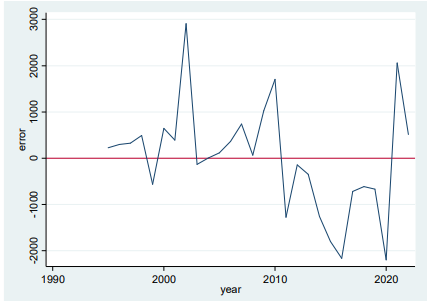Agriculture and Economic Growth in Nigeria (1990-2022)
Main Article Content
Abstract
The performance of agriculture in the economic growth of Nigeria between 1990 and 2022 was examined to assess its failures and successes to meet the Millennium Development Goals (MDGs) and currently the Sustainable Development Goals (SDGs). These international development policies as initiated by the United Nations stress combating extreme poverty in the world. Agriculture with its component parts of crop production (cp); livestock (li); forestry(fo) and fisheries (fi) and their response to the Gross Domestic Product (GDP) was reviewed using secondary data that were sourced from the National Bureau of Statistics (NBS) andtheCentral Bank of Nigeria statistical bulletin. Analysis was made using the Vector Auto Regression (VAR) model to the component parts of agriculture within the temporal space of 1990-2022. Other coefficients of the VAR that were used included the unit root test; lag length criteria; stability condition test; Engle and Granger test and the test of autocorrelation. Theresults of the fitted model are that the coefficients of lags 1,2 and 3 of GDP, lag 1 of cp, lags2 and 3 of li, lags 1 and 3 of fo, and lags 1,2 and 3 of fi indirectly affected GDP. At lags 2 and 3 of cp, lag 1 of li, and lag 2 of fo affected GDP directly. Livestock, forestry and fisheries respectively affected other variables implying some relationship that can predict future values.Therefore, crop production-groundnuts, oil palm, rubber, cocoa etc. as it was until late1980 sis a major driver of the nation’s economy hence contributing significantly to GDP. The paper therefore suggests that a return to agriculture with rich investments in the component parts will sustainably strengthen the economy and further improve GDP.
Downloads
Article Details
Section
How to Cite
Share
References
Adewumi, M.O. and Omotesho, O.A. (2002). An analysis of production objectives of small scale rural farming households in Kwara state, Nigeria, Journal of Rural Development,25:201-211.
Chauvin, N; Mulangu, F. and Porto, G. (2012). Food production and consumption trends in sub-Sahara Africa. Prospects for the transformation of the Agriculture sector. UNDP working paper for African Human Development Report pp.1-74
Christopher S. (1980), Macroeconomics and reality. Econometrica vol.48 (1), 1 – 48.
Christopher, S., Stock, J. H. and Watson, M. W. (1990), Inference in Linear time series models with some unit roots, Econometrica, vol.58 (1), 113 – 144
CIA (2013). The World Fact Book. Retrieved: March 3, 2013; from https://www.cia.gov/library/publications/the-world-factbook/goes/ni.html
Federal Ministry of Agriculture and Rural Development (FMARD) (2012). Nigeria fertilizer Strategy report Abuja Nigeria: Africa Fertilizer Summit.
Granger,C. W. J., (1969), Investigating causal relations by econometric model andcross-spectral method. Econometrica, vol.37 (3), 424 – 438.
Gujarati, D. N. and Porter, D. C. (2009), Basic Econometrics, 5th edition. McGraw Hill New York.
Lipton, M. (2012). Learning from alters: increasing Agricultural productivity for human development in the sub-Sahara. United Nations Development Programme; Regional Bureau for Africa.
NBS (2018). National Bureau of Statistics. Working paper Abuja, FGP. Nzeka, U. (2013). Grain and feed Annual; Animal Report 2013. USDA Foreign Agricultural service.
Obilor, S.I. (2013). The impact of commercial banks’ credit to agriculture on agriculture development in Nigeria. An Econometric Analysis. International Journal of Business, Humanities and Technology. Vol.3 No.1; 85-94
Olajide, O.T. (2012). Agriculture resource and economic growth in Nigeria. European Scientific Journal, 8, 22-30
Sekunmade, A. (2009). The effects of petroleum dependency on Agricultural trade in Nigeria. An error correlation modelling (ECM) approach. Scientific Research and Essay. 4(11),1395 – 1391.
Statistical Research Development (SRD) (2023). Agricultural Sector growth in Nigeria from 1999-2022.
Stock, J. H. and Watson, M. W. (2001), Vector Auto Regression. Journal of Economic Perspective vol. 15 (4), 101 – 115


